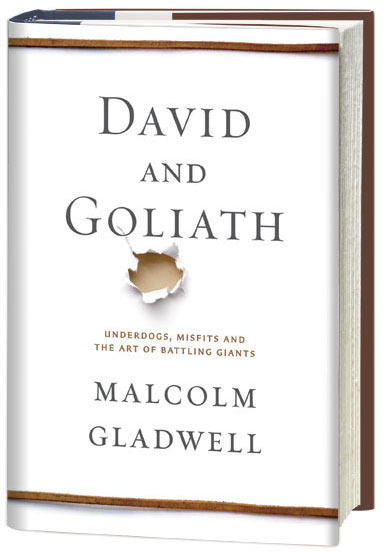Book Review: Malcolm Gladwell's David and Goliath
 Malcolm Gladwell’s latest — David and Goliath: Underdogs, Misfits, and the Art of Battling Giants
Malcolm Gladwell’s latest — David and Goliath: Underdogs, Misfits, and the Art of Battling Giants – came out this week. Like every other book by Gladwell, it is already a best-seller. And having read – and very much enjoyed — the book, I can see why. Gladwell once again presents a variety of interesting stories, this time centered on the question of whether underdogs are as disadvantaged as we believe (the opening story on David and Goliath – which makes this observation – is worth the price of admission). My sense – from the few reviews I have seen – is that critics have primarily focused on whether the argument they think Gladwell is making is valid. I am going to argue that this approach misses the fact that the stories Gladwell tells are simply well worth reading (i.e., these stories are interesting and make you think).
The range of stories Gladwell presents is quite impressive. From the opening biblical story to a discussion of the number of students in a school classroom, the impact of dyslexia, the curing of leukemia, the battle for Civil Rights, French revolutionaries during World War II, etc… One has to wonder: where does Gladwell find these stories?
The simple answer can be found in the end notes (which I encourage people to read). Gladwell primarily employs stories previously told in academic journals and academic books. For example, nearly a dozen different academic sources are employed to tell the story of David and Goliath.
Of course, someone could just go read the original academic sources. But I suspect there is a problem with that approach.
To illustrate, let me repeat something that Alfred Marshall, the father of microeconomics, wrote in a 1906 letter to A.L. Bowley.[1] Marshall’s letter serves as a famous comment on the role that abstract math plays in academic research:
Step One: Use mathematics as a shorthand language, rather than as an engine of inquiry.
Step Two: Keep to them until you have done.
Step Three: Translate into English
Step Four: Then illustrate by examples that are important in real life.
Step Five: Burn the mathematics.
Step Six: If you can’t succeed in (4), burn (3). This last I did often.
The point Marshall is making in this letter is simple: academic research should be connected to “real life.” But unfortunately, I don’t think Marshall’s advice is often followed. Abstract reasoning in academia – reasoning that is only accessible to other academics (and often, not many of those) – is prized. Actually connecting what is being said to real life is not considered very important. As a consequence, much of what is said by academics is not read by many people (the inside joke is that the average number of readers of an academic article is essentially one).
So the stories that academics tell just remain in journals that few people ever see. Consequently, it seems there is a clear market opportunity for people who have some ability to write. Specifically, Gladwell’s success telling these stories suggests other writers could follow his lead. Yes, it is possible that the writing skills of Gladwell are quite rare (he is quite good). But the ability to take the first step (i.e. read the stories) should not be that rare.
Of course, there are a few steps after the visit to your local university library. Gladwell clearly interviews the researchers. He also makes a clear effort to “illustrate what they are saying with examples that are important in real life.” And finally, he makes an effort to show how a collection of different stories really have a clear connection. So what Gladwell does goes beyond just being a “good writer.”
I believe there are more than 600 academic journals just in economics. That is a huge number of potential stories just in the economics field. All one has to do is start reading!
[1] This was noted in Harry Landreth and David Colander. History of Economic Thought, 3rd Edition. Houghton Mifflin Company. 1994.

Comments